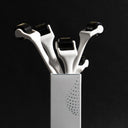Are you struggling with a receding hairline and wondering if a hair transplant is the right solution for you?
Receding hairline hair transplants have become a popular option for restoring hair and confidence.
This guide covers the procedure, benefits, risks, and recovery, helping you make an informed decision.
Whether you're just exploring options or ready to take the next step, we've got you covered.
Table of content
Why do you have a receding hairline?

There are numerous causes of receding hair. However, the most common cause is age and genetic factors. According to the Journal of Investigative Dermatology, by the time men are 80, 80% of them have a receding hairline.
On an average person's scalp, the follicles under the skin's surface create roughly 100,000 hairs. Over time, these hairs inevitably fall out and are replaced by fresh ones.
Every day, you may lose a dozen hair strands. A receding hairline can be caused by damaged hair follicles or by a medical condition that interferes with the growth cycle.
Moreover, hair loss and a receding hairline might be exacerbated by other conditions. These include:
- Consuming a diet rich in saturated fat.
- Making tight hairstyles like braids and cornrows.
- Excessive hair styling, especially with the heat.
- Coloring hair with chemicals like bleach and peroxide.
- Processed foods, sugar, and preservatives.
- Inflammatory conditions of the scalp, such as frontal fibrosing alopecia or lupus.
- Bad smoking habits.
- Hormonal changes in females.
- And the sensitivity of hair follicles is also affected by the genes.
- Stress
Additionally, hair loss may result from specific medical procedures or treatments. A prominent illustration is a chemotherapy, which frequently results in hair loss in patients.
As your leading source for hair health information over the past 4 years, we never compromise on accuracy. When it comes to your health, you deserve information you can truly rely on - and earning your trust is our top priority.
Here's how Scandinavian Biolabs ensures every piece of content meets the highest standards of accuracy and integrity:
- Credentialed Experts: Our reviewers are actively practicing doctors and medical researchers
- Stringent Reviews: Content undergoes rigorous editing by subject specialists and review by a practicing doctor.
- Evidence-Based: We rely on well-established research from trusted scientific sources like peer-reviewed journals and health authorities.
- Full Transparency: Our editorial standards, writer credentials, reviewer credentials, correction process, and funding are all publicly documented.
- Independent Voice: While we do promote products, we operate in a vacuum to business operations. Our main goal is just an unwavering commitment to providing medically-sound guidance.
You can count on Scandinavian Biolabs to consistently deliver the trustworthy health information you deserve. Read our Editorial Standards.
Is hair transplant surgery safe for a receding hairline?

Hair transplant surgery for a receding hairline is generally considered to be safe when performed by a qualified, experienced, and board-certified plastic surgeon.
However, it is important to be aware that not all men will benefit from hair transplant surgery, as hair loss following a procedure can make it look unnatural after 15-20 years.
Common side effects after a hair transplant may include soreness, swelling, inflammation of the treated area, and small pimples at transplant sites.
It is also possible for an unnatural, "patchy" appearance to develop if hair loss worsens following surgery, particularly if newly transplanted hair is close to areas of hair still in the process of thinning. In these cases, further surgery may be necessary.
Read this: The 12 Best Natural and Drug Hair Transplant Alternatives
Side effects of hair transplant
Here are some side effects of a hair transplant:
Bleeding
There will undoubtedly be some scrapes and wounds, as well as some blood loss, whether you have a follicular unit transplant or any other hair transplant technique.
A piece of gauze can contain any oozing that develops in the postoperative period, even though most skilled doctors will work to keep blood loss to a minimum.
Therefore, the patient must disclose any blood-thinning medications or any bleeding-related conditions they may have.
Infections
Even with the best talents, you may contract an infection that requires a short course of antibiotics. If you have picked a decent doctor, you can be assured that you won't have to haggle with any infections.
Itching
Most patients who receive a hair transplant experience itching, possibly the most common side effect. In the transplant area, scabs develop, which cause itching.
To keep the grafts healthy, spritz the prescribed solution over them and wash your scalp with a light or medicated shampoo after the first or second week following surgery. Like other side effects, the itching will disappear over a few days.
It can sometimes be brought on by minoxidil, which should be stopped because of its usual negative effects.
Swelling
Another frequent adverse effect most patients who have received the procedure report experiencing is swelling. The areas of swelling, however, may vary between individuals.
The swelling may be around the eyes for some people, while it may be on their forehead for others. There might even be what you would refer to as a "black eye" in some circumstances.
Usually, swelling tends to go down after a few days, but it would be preferable to see a doctor if this did not occur.
Non-surgical hair transplant alternatives for a receding hairline
Numerous studies have demonstrated that non-surgical treatments can stop hair loss and thinning. Still, the results differ from person to person.
However, one of the main benefits of non-surgical treatment is that it is non-invasive and, for the most part, painless.
Besides, hair transplantation also results in scars, infections, and anesthesia problems that usually do not occur with non-surgical procedures.
1. Scandinavian Biolabs Hair Growth Routine

If a hair transplant is not what you need, the Scandinavian Biolabs Hair Growth Routine is the first and safest choice. It is intended to help promote healthy hair growth and stop hair loss. Because substances from plants back the product, it is cruelty-free.
Its ingredients support hair growth by nourishing hair follicles. So, if you want your hair to grow naturally within 150 days, this hair growth regimen is your best chance. It uses ingredients that stimulate hair follicles and encourage hair growth.
2. Platelet-rich plasma therapy (PRP)
The best non-surgical hair regrowth method is platelet-rich plasma or PRP. In this process, blood is extracted, processed, and injected into the scalp to prevent hair loss.
According to some medical professionals, PRP injections increase the blood flow to the hair follicles and thicken the hair shaft, promoting and maintaining natural hair growth. However, this method is occasionally used with other treatments or drugs for hair loss.
3. Low-level laser therapy
LLLT is a state-of-the-art, non-surgical approach to healing hair loss that encourages cell proliferation as well as hair follicle growth. It stops hair loss while improving hair volume and appearance.
Both the treatment and any negative side effects emerging from the treatment are painless. In short, it is generally used to treat androgenetic alopecia, often known as male or female pattern baldness.
4. Scalp micropigmentation
A cosmetic treatment for hair loss or thinning hair is scalp micropigmentation. It is also occasionally referred to as a "hair tattoo."
The process involves applying tiny spots of pigment (the color of your choice) to the scalp using thin, small needles. These specks, as a result, give the impression that the hair is fuller and thicker.
5. Medications
Another great non-surgical option is to take minoxidil and finasteride, a blessing in disguise for hair loss. Using minoxidil will expand blood vessels, which ultimately enhances scalp blood flow. The hair follicles receive more nourishment, which encourages hair growth.
On the other hand, finasteride prevents the production of the DHT hormone, which is responsible for reducing hair follicle size and, ultimately, hair loss.
Which hair transplant technique works best for a receding hairline?

Although there are several different hair transplantation methods, Follicular Unit Extraction (FUE) is the most advanced. Because it reconstructs your hairline one hair graft at a time, this procedure generates flawless results.
Besides this, the FUT (Follicular Unit Transplantation) procedure is a strong competitor to the Follicular Unit Extraction method. However, FUE is by far the most common.
The Follicular Unit Extraction (FUE) method of hair transplantation involves taking donor hair from denser areas and transplanting it to areas with partial or full hair loss.
Numerous advantages of FUE hair transplantation include:
- An easy-to-follow procedure that delivers results.
- Scars are hardly visible.
- 90% of hair grafts survive.
- Speedier recovery
However, Follicular Unit Extraction incisions must close and mend in around 5 days. The complete recovery, however, is anticipated to take two to three weeks.
At this point, hair begins to shed, showing follicle growth. The growth of scalp-implanted hair takes three to four months.
Does your hairline still recede after a hair transplant?
After undergoing a hair transplant, your newly transplanted hairline should hold up over the long term. The transplanted hair follicles are typically taken from areas of your scalp that are resistant to hair loss, so they are likely to produce hair for the rest of your life.
However, as you age, it's possible that these follicles might thin, but they will continue to produce at least some hair. It's important to note that if your natural hair thinning continues, it won't follow the same pattern as your previous hair loss.
Instead, the hairline created during the transplant will remain stable, giving you a more permanent solution to your receding hairline.
When is it too late for a hair transplant?
Determining the right time for a hair transplant depends largely on the extent of your hair loss. Generally, balding and hair thinning can be effectively treated up to Norwood stage 6, which is characterized by significant hair loss and a large bald area on the top of the scalp.
If your hair loss has progressed beyond stage 6, it might be too late for a hair transplant. In such cases, there may not be enough donor hair available to achieve a satisfactory result.
Consulting with a hair restoration specialist can provide you with personalized advice based on your specific situation and help you explore alternative treatments if necessary.
How long does it take to see results from a hair transplant for a receding hairline?
After a hair transplant, most people notice improvements within six to nine months, though it can take up to a year for some patients. According to health specialist Ashley Ash, "It's crucial to understand that the transplanted hair will fall out two to eight weeks after the procedure."
In some cases, areas may grow and mature more slowly, taking up to 18 months to see final results. Patience is key during this period as your new hair gradually comes in.
What is the cost of a hair transplant for a receding hairline?
Numerous variables influence the price of a hair transplant. Depending on the specifics of the service and how much is required, the final cost will be determined. The average price might be between $4000 and $15,000, depending on the number of grafts you need.
Conclusion
Having a receding hairline can be stressful and emotionally draining. Hair transplant surgery is the most advanced and permanent solution, costing between $4,000 and $15,000 depending on the number of grafts needed. However, it comes with potential side effects and may not be suitable for everyone.
Thanks to new technologies, there are now many non-surgical treatments, such as PRP, low-level laser therapy, scalp micropigmentation, and medications. The Scandinavian Biolabs Hair Growth Routine is another effective, natural option.
Before deciding on any treatment, consult with a qualified and experienced hair transplant surgeon to determine the best method for your needs and understand the necessary steps to achieve your desired results.
References:
- https://www.ncbi.nlm.nih.gov/books/NBK547740/
- https://www.ncbi.nlm.nih.gov/pmc/articles/PMC3764754/
- https://www.ncbi.nlm.nih.gov/pmc/articles/PMC10333515/
- https://www.ncbi.nlm.nih.gov/pmc/articles/PMC4338465/






